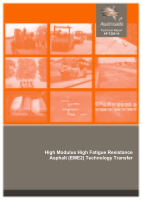Pavement

- Publication no: AP-T283-14
- ISBN: 978-1-925037-93-7
- Published: 14 November 2014
- PDF (free) Download
This report details the first year of a three-year Austroads project to transfer French Enrobés à Module Élevé Class 2 (EME2) technology to Australia. EME2 technology offers the prospect of reduced asphalt thicknesses for heavy duty pavements, and lower construction and maintenance costs.
In this first year of the project, an Australian specification framework for EME2 mixes was developed and the requirements for manufacturing, paving and compliance were provided. Tentative specification limits for EME2 mixes were set using Australian test methods for workability, wheel tracking, flexural stiffness, fatigue, and moisture sensitivity.
As part of the validation process a successful demonstration trial was carried out on Cullen Avenue West, Eagle Farm, Queensland. Data from the laboratory and field studies was analysed and the outcomes are summarised in the report. Based on the laboratory and field data collected so far, the EME2 pavement shows performance as expected.
- 1. Introduction
- 1.1. Background
- 1.2. Scope and Objectives
- 1.3. Report Structure
- 2. Technical Basis of EME2 Mix Specification in Australia and Experimental Plan
- 2.1. French EME2 Mix Design Requirements
- 2.1.1. Binder Requirements
- 2.1.2. Aggregate Requirements
- 2.1.3. Mix Design
- 2.2. Technical Basis of the EME2 Mix Specification in Australia
- 2.2.1. Binder Testing and Specification Requirements
- 2.2.2. Requirements for Coarse and Fine Aggregate and Fillers
- 2.2.3. Asphalt Mix Design, Testing and Specification Requirements
- 2.2.4. Performance Requirements for the Mix
- 2.2.5. Monitoring the Production
- 2.2.6. Production Process Control
- 2.2.7. Compaction Process Control
- 2.2.8. Compliance of the Constituent Materials
- 2.2.9. Compliance Testing of the Asphalt Mix
- 2.2.10. Preparatory Works, Characteristics of the Subgrade/Working Platform
- 2.2.11. Manufacturing and Paving Temperatures
- 2.2.12. Compliance Testing of the Pavement and Finished Asphalt
- 2.3. Developing Tentative Specification Limits for the Mix
- 3. EME2 Transfer in Other Countries
- 3.1. United Kingdom
- 3.1.1. Belgium
- 3.1.2. Poland
- 3.1.3. Switzerland
- 3.1.4. Indian Ocean Region
- 4. Replicating a Conforming French EME2 Design using Australian Test Methods
- 4.1. Filler and Aggregate Testing
- 4.2. Hard Penetration Grade Binder (EME Binder) Testing
- 4.2.1. Brookfield Test Results
- 4.2.2. DSR Test – Temperature-frequency Sweep
- 4.3. Laboratory Mixing and Initial Testing
- 4.3.1. Workability
- 4.3.2. Stiffness (Resilient Modulus) According to AS 2891.13.1
- 4.3.3. Wheel Tracking According to AGPT-T231
- 4.3.4. Flexural Stiffness Testing
- 4.3.5. Fatigue Resistance According to AGPT-T233
- 4.3.6. Moisture Sensitivity According to AGPT-T232
- 4.4. Tentative Specification Limits Based on Laboratory Testing
- 4.4.1. Workability
- 4.4.2. Wheel-tracking
- 4.4.3. Flexural Stiffness
- 4.4.4. Fatigue
- 4.4.5. Moisture Sensitivity
- 4.4.6. Summary of the Tentative Specification Limits
- 5. EME2 Queensland Trial
- 5.1. Background
- 5.2. Project Delivery
- 5.3. Trial Objectives
- 5.4. About the Pavement Instrumentation
- 5.5. Pre-construction Testing
- 5.5.1. Falling Weight Deflectometer (FWD) Testing
- 5.6. Construction
- 5.6.1. Profiling and Preparatory Works
- 5.6.2. Paving Sequence
- 5.6.3. Rolling Patterns
- 5.6.4. Surface Gritting
- 5.7. Construction Quality Assurance Testing
- 5.7.1. Material Production
- 5.7.2. In situ Density Testing and Laying Temperatures
- 5.7.3. Temperature Monitoring
- 5.7.4. Nuclear Density Testing, 20 m Frequency
- 5.7.5. Sand Patch Testing
- 5.7.6. Surface Evenness
- 5.8. Surface Appearance
- 5.9. Geometric Survey of the EME2 Trial Site
- 5.10. Post-construction Testing
- 5.10.1. Density Testing on Cores Extracted from the Pavement
- 5.10.2. British Pendulum Test (BPT) and Sand Patch Data
- 5.10.3. SCRIM Test
- 5.10.4. Falling Weight Deflectometer (FWD) Testing
- 5.10.5. Network Survey Vehicle
- 5.11. Temperature Monitoring during Construction using Thermography
- 5.11.1. Thermal Segregation
- 5.11.2. Thermography
- 5.11.3. Procedure
- 5.11.4. Apparatus
- 5.11.5. Observations
- 5.11.6. Laboratory Testing of Production Material
- 5.12. Pavement Instrumentation
- 5.12.1. Construction of the Pavement Box
- 5.12.2. Installation of the Strain Gauges
- 5.12.3. Installation of the Temperature Sensors
- 5.12.4. Installation of the Weather Station
- 5.13. Wearing Course Construction
- 5.13.1. Wearing Course Placement
- 5.13.2. Temperature of the Mat
- 5.13.3. Tack Coat Application Rate
- 5.13.4. Thermal Imaging during Paving
- 5.13.5. Construction Monitoring, Density Testing
- 5.13.6. Line Marking
- 5.14. Observations on the Test Section
- 6. Summary and Conclusions
- References
- Appendix A Construction Drawings
- Appendix B Trial Site Layout
- Appendix C Summary of EME2 Trial Site Feature Locations
